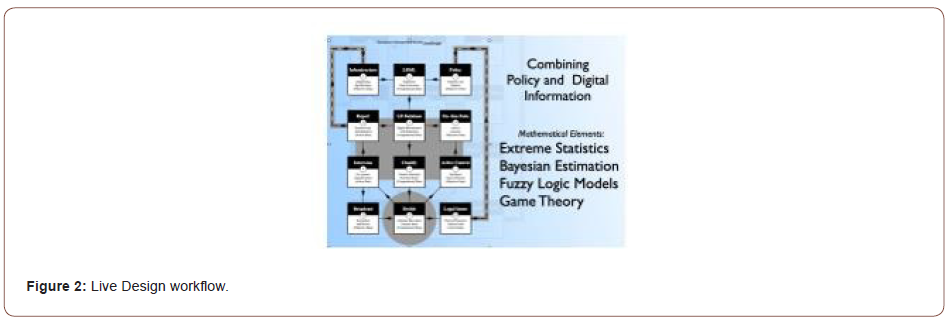 Mini Review
Mini Review
Current Trends from Safety to Security Engineering
Gautam Dasgupta, Columbia University, New York, NY, USA.
Received Date: February 17, 2022; Published Date: March 22, 2022
Introduction
Safety Engineering mitigates normal events. Its contemporary equivalence, for extreme disasters, demands the deployment of Statistics of Extremes, Gumbel [1]. Civil Engineering research has addressed extreme natural and industrial disasters by employing extreme statistical distributions of Gumbel and Weibull types, respectively. The author demonstrated that the Fr´echet distribution could model manmade extreme disasters. Their combined elects constitute the background of this novel endeavor. Interestingly, it has been mathematically established that only three kinds of extreme distributions (Gumbel, Fr´echet and Weibull (also called the Type-I, II and III, respectively)) are possible. Furthermore, from civil engineering application viewpoints, these distributions do not depend upon the parent distributions of events. Due to the overwhelming needs to mitigating extreme events, Security Engineering tools, both software and hardware, have increasingly becoming an active area of research and development.
From Reliability to Resilience
Barring infrequently occurring but highly damaging disasters, advancement in designs, constructions and material technologies have made our infrastructure systems to be safe to a highly satisfac tory level. E↵orts in this traditional reliability based conventional designs are spent before any constructed facility is made available for human usage. For example, in the United States, Hurricane Katrina (2005), 9/11 attacks (2001) and the Deepwater Horizon oil rig explosion (2010) demanded mitigations during and after disasters. This class of problems, figure 1(a), propelled the Live Design paradigm to initiate SecurityEngineering. For normal events, vast amount of literature, e.g., Zhu, Keshtegar, Trung, Yaseen, and Bui [2], is available on safety engineering governed by the reliability index. Resilience is its counterpart for possibility based extreme events, figure 1(b), Dasgupta [3]. The author introduced a formal quantification of a nondimensional resilience in Dasgupta [4]:

The overwhelming demand on SecurityEngineering is to ensure all infrastructure to be environmentally friendly. This leads to combining all three types of extremes so that ⇢ in eq. (1) can be estimated a priori from spatio-temporal threat contours, figure 1(c) (Figure 1).
During this COVID-19 pandemic, words like – extreme, infrequent, unprecedented, un- expectedly severe, massively disruptive have entered into our everyday vocabulary. Historically, figure 1(a), Civil Engineering, have addressed safety and security issues, figure 1(b). The current trend is anticipated to be a real time navigation through contours of threats, figure 1(c), posed by combining natural, manmade and industrial disasters.

Computational thinking bridges the gap between computer technology oriented hard and software enhancements and the real need of civil societies. The current trend in civil engineering inevitably paves that path via this proposed SecurityEngineering. Civil engineering design is a living process, constantly adjusting to the needs while safe- guarding against disasters. Live Design, the workflow in figure 2 attempts to implement those tasks. In conclusion, as we encounter extreme events – amongst which the climate disaster holds the unfortunate paramount position – we are, naturally, transcending from Safety Engineering to Security Engineering (figure 2).

Acknowledgement
None.
Conflict of Interest
No conflict of interest.
References
- Gumbel EJ (2021) Statistics of Extremes. Dover Publications. Original publication in 1958 by Columbia University Press, New York, NY, USA.
- Shun-Peng Z, Behrooz K, Nguyen-Thoi T, Zaher MY, Dieu TB (2021) Reliability-based structural design optimization: hybridized conjugate means value approach. Engineering with Computers, 37(1): 381–394.
- Gautam Dasgupta (2011) Emergency response management apparatuses, methods, and systems. US Patent Application.
- Gautam Dasgupta (2015) Quantifying resilience. In: Osaka U (Ed.) DS’15 Conference on Disaster Simulations.
-
Gautam Dasgupta. Current Trends from Safety to Security Engineering. Cur Trends Civil & Struct Eng. 8(4): 2022. CTCSE.MS.ID.000693. DOI: 10.33552/CTCSE.2022.08.000693.
-
Civil engineering, Damaging disasters, Designs, Constructions, Material technologies, Bridge
-

This work is licensed under a Creative Commons Attribution-NonCommercial 4.0 International License.






